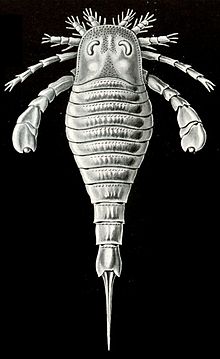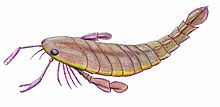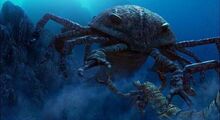Eurypterids (sea scorpions) are an extinct group of arthropods that are related to arachnids and include the largest known arthropods to have ever lived. They are members of the extinct order Eurypterida (Chelicerata); which is the most diverse Paleozoic chelicerate order in terms of species.[1] The name Eurypterida comes from the Greek wordseury- (meaning "broad" or "wide") and pteron (meaning "wing").[2] This name was chosen due to the pair of wide swimming appendages on the first fossil eurypterids discovered. The largest, such as Jaekelopterus, reached 2.5 metres (8 ft 2 in) in length, but most species were less than 20 centimetres (8 in). They were formidable predatorsthat thrived in warm shallow water, in both seas and lakes,[3] from the mid Ordovician to late Permian (470 to 248 million years ago).
Although informally called "sea scorpions", only the earliest ones were marine (later ones lived in brackish or freshwater), and they were not true scorpions. According to theory, the move from the sea to fresh water had probably occurred by the Pennsylvanian subperiod. Eurypterids are believed to have undergone ecdysis, making their significance in ecosystems difficult to assess, because it can be difficult to tell a fossil moult from a true fossil carcass.[4] They became extinct during the Permian–Triassic extinction event 252.17 million years ago. Their fossils have a near global distribution.
About two dozen families of eurypterids are known. Perhaps the best-known genus of eurypterid is Eurypterus, of which around 16 fossil species are known. The genusEurypterus was described in 1825 by James Ellsworth De Kay, a zoologist. He recognized the arthropod nature of the first-ever described eurypterid specimen, found by Dr. S. L. Mitchill. In 1984, that species, Eurypterus remipes was named the state fossil of New York.
Pentecopterus decorahensis, which lived as early as 467.3 million years ago, is the oldest described eurypterid; with an estimated length of 1.83 metres (6 ft 0 in),[5][6] it has been described as "the first real big predator".[7][8]




